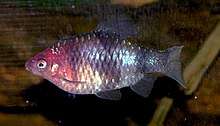Black ruby barb
The black ruby barb (Puntis nigrofasciatus) or purplehead barb is a tropical cyprinid fish endemic to Sri Lanka, where it occurs in forested streams from the Kelani basin to the Nilwala basin. They are found in streams on hills around 1000 ft (300 m) in elevation. The brightly colored population introduced to Mahaweli at Ginigathena, Sri Lanka is said to have diminished in number due to the aquarium export trade.[2][3]
| Black ruby barb | |
|---|---|
 | |
| Scientific classification | |
| Kingdom: | Animalia |
| Phylum: | Chordata |
| Class: | Actinopterygii |
| Order: | Cypriniformes |
| Family: | Cyprinidae |
| Subfamily: | Barbinae |
| Genus: | Pethia |
| Species: | P. nigrofasciata |
| Binomial name | |
| Pethia nigrofasciata (Günther, 1868) | |
| Synonyms | |
| |
Description
The young fish has a yellowish gray body with black vertical stripes. The silver body turns into a dark ruby red color in mature, breeding males. In the female, the basal part of all the vertical fins is black. In the male, the whole dorsal fin is a deep black, the anal fin blackish red, and the pelvic fins are reddish. The fish will grow to a maximum length of 2–3 inches (6–8 centimeters) with the female being slightly longer than the male.
Water conditions
Black ruby barbs natively live in a tropical climate among cool, shady, quietly flowing forested streams with either gravel or sand substrates. Their diet mainly consists of filamentous algae and detritus. They prefer water with a 6.0–6.5 pH, a water hardness of 5–12 dGH, and a temperature range of 72–79 °F (22–26 °C).
Commercial importance
The fish has commercial importance in the aquarium hobby, and is successfully bred in captivity. They are also used to create hybrid forms of "tiger barbs" for the aquarium trade.
Breeding
An egg-scatterer, the fish spawn more than 100 eggs in shallow water among the plants. The eggs hatch in one to two days and then will be free-swimming after 24 hours.
In the aquarium
Plenty of room should be provided for this fish, with plenty of light and a shallow covering of floating plants and ample vegetation (half to two-thirds of the tank area). A layer of humus should be left on the bottom. This species is good for keeping with other barbs and similar fish. In captivity, the fish are omnivorous, with a healthy appetite.
The black ruby barb is an active swimmer that is best kept in schools of at least six.
References
- Michael K. Oliver, ed. (1977). Simon & Schuster's Guide to Freshwater and Marine Aquarium Fishes. New York, New York: Simon & Schuster, Inc. pp. 50. ISBN 0-671-22809-9.
- de Alwis Goonatilake, S., Fernado, M. & Kotagama, O. (2019). "Pethia nigrofasciata". The IUCN Red List of Threatened Species. IUCN. 2019: e.T18895A117405764.CS1 maint: multiple names: authors list (link)
- Pethiyagoda, R., Meegaskumbura, M. & Maduwage, K. (2012): A synopsis of the South Asian fishes referred to Puntius (Pisces: Cyprinidae). Ichthyological Exploration of Freshwaters, 23 (1): 69-95.
- Froese, Rainer and Pauly, Daniel, eds. (2013). "Pethia nigrofasciata" in FishBase. April 2013 version.
